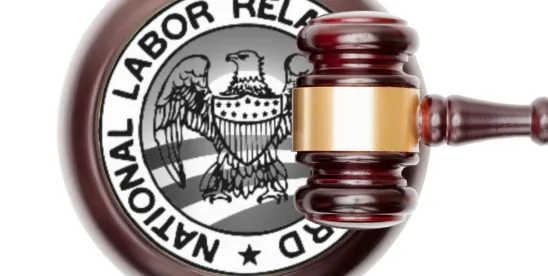On March 8, 2024, a federal judge in the United States District Court for the Eastern District of Texas dealt a serious blow to the National Labor Relations Board’s (the “Board”) efforts to further increase the reach of the National Labor Relations Act (“the NLRA”). Judge J. Campbell Barker struck down a final rule issued by the Board that would have drastically broadened the standard the Board applies to determine when employers are joint-employers for the purposes of federal labor law. The blow was delivered three days before the rule was set to take effect on March 11, 2024 following a 14-day stay order also issued by Judge Barker.
Judge Barker vacated the Board’s final rule on the standard for determining joint employer status (“Final Rule”) holding that the test was unlawfully broad as it would allow an entity to be deemed a joint employer with or without any exercise of meaningful control over the disputed employees’ terms and conditions of employment.
Background
As we previously reported, the Final Rule, released by the Board in October 2023 and initially set to take effect February 26, 2024, lowered the standard for determining joint-employer status under the NLRA. The Final Rule would have made it easier for the Board to find a joint employer relationship than under the previous joint employer test by (1) applying a standard that defined entities as joint employers if the two share or codetermine the employee’s essential terms and conditions of employment, as opposed to only when the entity had direct and immediate control of the same; (2) defining the essential terms and conditions of employment as overlapping with the NLRA; and (3) including reserved or indirect control of the essential terms and conditions of employment as sufficient to trigger joint employer status based on a case-by-case analysis.
This was a substantial shift from the previous rule that required actually sharing or codetermining essential terms and conditions of employment in a way that demonstrates direct and immediate control that has a regular or consequential effect, and is not merely routine, and stated that proof of indirect control, or contractually reserved but never exercised control over essential terms of employment, standing alone, was not enough to establish joint employer status.
It was anticipated that the Final Rule would drastically increase the number of employers obligated to bargain over employees’ essential terms and conditions of employment as well as increase the number of employers potentially liable for unfair labor practices of contracted employees.
Judge Barker’s Decision Vacating the 2023 Joint Employer Rule
The Final Rule came before Judge Barker via a lawsuit initiated by the United States Chamber of Commerce (“the Chamber”)—and a coalition of business groups—alleging the rule was arbitrary and capricious, and therefore unlawful, in part because it fails to articulate a comprehensible standard and ignores serious practical problems.
The Final Rule establishes a two-part test for determining if an entity is a joint employer. Step one of the test requires a finding that the entity is a common law employer of the pertinent employees and step two requires that the employer share or codetermine essential terms of employment.
The Chamber argued that the second test is always met if the first step is met. Additionally, the Chamber also argued that under the Final Rule indirect control of essential terms of employment are enough to establish a joint employer relationship even if the other elements of the test are not met.
In response, the Board disputed the two prongs were one in the same, arguing there may be cases where a business could be deemed a common law employer and not have control over one of the essential terms of employment. The Board further argued that the Chamber misrepresented what the Final Rule allows, and the indirect control of essential terms of employment applies to the second step of the test, and does not alone establish a joint employer relationship.
In the decision, Judge Barker criticized the “two prong” test of the Final Rule and determined that the test only has one step for all practical purposes, holding that the second step of the test is not a unique step but is “either co-extensive with step one or a superset of step one.” Judge Barker explained that “[a]n employer of a worker under the common law of agency must have the power to control ‘the material details of how the work is to be performed,’” and that control would itself meet step two’s requirement.
In doing so, Judge Barker not only accepted the Chamber’s contention that any time the first step is met the second step is also satisfied, but went further to point out that the Board was unable “to come up with any example of an entity satisfying step one but not step two.”
More significantly, Judge Barker outlined the ways in which the Final Rule is overbroad, explaining than an entity could be deemed a joint employer by simply having the right to exercise indirect control over one essential term or condition of employment without any need to demonstrate an employment relationship under the common law of agency. Examining subsection (e)’s express language in the Final Rule, the second step served as a standalone basis for finding joint employer status (the defined power to control “is sufficient to establish status as a joint employer.”) Thus, the core problem, in Judge Barker’s view, was that subsection (e), as written, colored outside the lines of common law employment and the two step test was not actually capable of confining the control test to common law employers. Judge Barker explained that the subsection’s plain text states indirectly exerting control over one or more essential terms or conditions is sufficient to establish joint employer status, and thus, “once the specified power is shown, joint-employer status attaches without any need to additionally demonstrate an employment relationship under the common law of agency.” Combined with the broad classification of many aspects of work as essential terms and conditions of employment, subsection (e)’s overbroad language would swallow the common law test and “treat virtually every entity that contracts for labor as a joint employer because virtually every contract for third-party labor has terms that impact, at least indirectly, at least one of the specified ‘essential terms and conditions of employment.’”
The decision provided examples of how the Final Rule could result in virtually every entity contracting with labor to be labeled a joint employer. For example, Judge Barker pointed out that a business that negotiates a contract for services, to be provided on a specific day and time on a cost-plus basis—cost of wages plus a percentage markup—indirectly controls both the hours of work and wages for employees of the service provider. Because both hours of work and wages are enumerated “essential terms of employment,” Judge Barker explained this would require finding the businesses joint employers.
The opinion also touched on the argument that the rule may be arbitrary and capricious as the purpose of rulemaking (as opposed to statutory law) is to increase the efficiency and predictability of applying the standard – a “definite, readily available standard” – whereas this Final Rule would likely result in more ambiguities than the common-law adjudication and more labor conflicts by forcing an underdefined categories of entities to participate in bargaining. Due to Judge Barker’s decision to vacate the Final Rule, the existing joint employer test, which requires “immediate and direct control of employees,” remains the applicable standard.
The Board still intends to implement the Final Rule, and is expected to appeal the decision to the United States Court of Appeals for the Fifth Circuit. The Final Rule also faces a still pending challenge in the United States Court of Appeals for the District of Columbia Circuit by the Service Employees International Union. The union argues that the Final Rule does not go far enough, and seeks to expand it to cover merely those businesses with the right to control the seven enumerated “essential terms and conditions of employment” but also those that have the ability to control any “mandatory subject of bargaining. Outside of the courts, earlier this month, the Senate voted in favor of a resolution to formally overturn the Final Rule under the Congressional Review Act.
Key Takeaways
While it is unclear if the Final Rule will take effect, the Board has shown its strong intention to continue enacting strong pro-employee policies and overturn some pro-employer decisions and rules that were implemented during the prior administration.
Employers should continue to evaluate their current arrangements and agreements with third-parties, subcontractors, staffing agencies and other entities to determine whether those agreements could risk a joint employer determination if the Final Rule takes effect. Employers should identify any provisions of agreements that could be interpreted as reserving the right to control any essential term or condition of another entity’s employees. This includes the right to set hours, wages, terminate, or discipline employees. Additionally, employers may want to consider altering their current practices with regards to employees of third parties that work on their premises to determine whether any conduct may indicate shared or codetermined control over that another entity’s employees.
Listen to this post
Wolfram Ott also contributed to this article.



 />i
/>i
